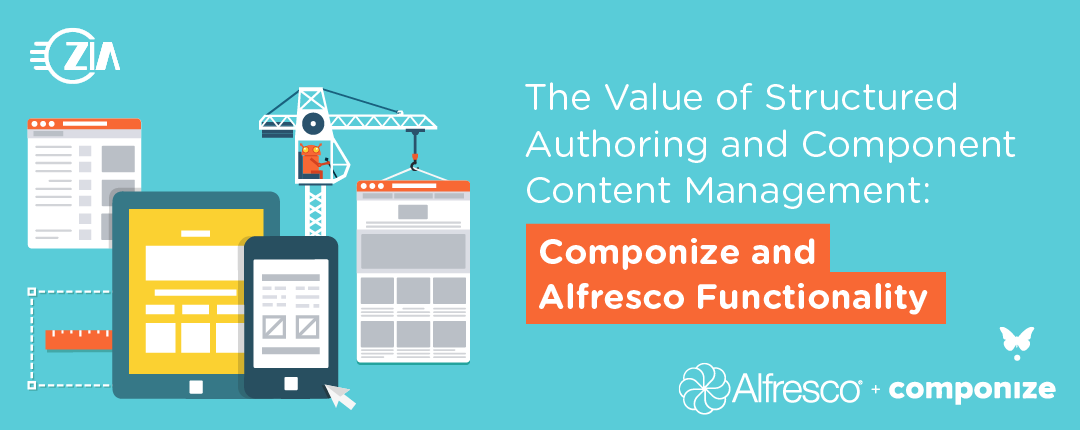At Zia, we utilize Componize for our Component Content Management (CCM) solutions. Componize is a component content management application built on top of Alfresco Content Services. Alfresco Content Services provides the enterprise content management platform, while Componize can turn Alfresco from an ECM solution into a CCM suite.
These six factors differentiate Componize from other CCM providers:
- Release management
- Translation management
- Flexible output processing
- Dynamic linking
- Integration with many authoring tools, both web- and desktop-based
- Open, integrated CCM/BPM/ECM platform
This blog will give a rubber-meets-the-road overview of why Componize and Alfresco are a great combination. Together, they provide seamless ECM and CCM functionality.
Release and Translation Management
Release management within Componize allows branching, merging, and tagging to support most organization’s release management needs. The Release Management module provides the required functionality for a simple tagging to ensure a match between a product release and its related content. It also provides functionality if you need a long-term branch to support documentation for a fork of a product for a specific customer.
The use of the release management module largely mirrors a software development lifecycle (SDLC) methodology. This feels natural to technical authors and easy to learn for subject matter experts. Additionally, workflow—provided by Alfresco Process Services—can further formalize release methodology.
As discussed by Zia’s Steve Studer in the CCM use case blog post, localization and translation can be core to CCM and technical authoring. Componize’s Translation management module streamlines this process, helping to identify where translation is needed within documentation.
Flexible Output Processing
Without the ability to generate and publish content based on the input XML, a CCM solution is incomplete. Componize goes one step further and provides a vast set of functionality to enable output processing for many formats out of the box and well-documented extensibility to provide further output formats. Componize’s pipelining is fast and efficient. Additionally, external services can be leveraged if desired.
Dynamic Linking
Many CCM solutions heavily obfuscate document linking. This provides long, difficult to parse reference IDs, stored externally in a database, with hidden mapping in the background. Componize, instead, uses a simple relative path when referencing content. Using relationships within the Alfresco content model, it’s still automatically able to update references should a file move. This dynamic linking is intuitive and simple.
Another benefit of handling dynamic linking in this way is that it greatly simplifies the import and export of DITA content into/from Componize. While other solutions require much more complex import/export procedures, Componize allows much more streamline portability.
Out-of-the-box Integration with Many Authoring Tools
At Zia, we let our customers work the way they want to work. This manifests in many ways, but for technical authoring and CCM, that means using the authoring tools they are most comfortable with. Out of the box, Componize supports oXygen Desktop, oXygen XML Web Author, and other authoring tools. So, whether our customer is looking for a desktop- or web-based solution, they can simply plug and play. From AuthorBridge, to Fonto, and beyond, each tool provides a different authoring experience. Additionally, Alfresco exposes the repository via WebDAV, which allows generic support for other authoring tools that can mount Alfresco as a file system. We want to provide options for our technical authors and SMEs, and Componize allows us to do that.
Open and Integrated CCM/BPM/ECM Platform
I’ve spoken primarily about Componize throughout this article. It’s important to remember that Componize lives on top of Alfresco Content Services, Process Services, and Governance Services. That means that any of the content (DITA topics, maps, and output) can participate in workflow and governance, version control, and all other functionality that Alfresco provides. While Componize focuses heavily on dealing with DITA content and component content management, Alfresco’s ECM functionality is the broad platform upon which this is all built.
Alfresco is open and easy to integrate against; Componize shares those same characteristics. This also means that, while a small part of an organization may leverage the authoring functionality that Componize provides, the rest of the organization can benefit from the content, process, and governance that the Alfresco suite of tools brings to the table. The resulting solution can be an enterprise-wide repository, with something for everyone within the organization.

